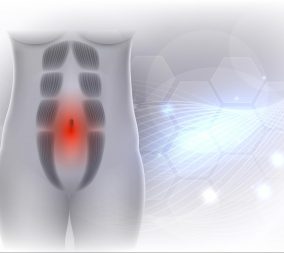Many patients ask about diastasis recti either during or after their pregnancy. (Although I’ve noticed many have a hard time pronouncing it. I believe it is dye-AS-tuh-sis… but I would also accept DYE-a-stay-sis and not look at you funny, because I have certainly said it that way before as well. Also it is correct to say diastasis recti or rectus diastasis, or rectus abdominis diastasis etc.
This is a condition where the abdominal wall muscles separate during or after pregnancy. Let’s take a quick look at what it is, why it happens and answer the ever important prevention/treatment questions.
What exactly is diastasis recti?
The rectus muscles (abdominal wall muscles) are connected with tissue called the linea alba. This tissue can separate and lead to doming or bulging appearance to the abdomen. A separation of greater than 2 finger breadths is considered abnormal. It is possible for a woman to have a significant separation of the linea alba with no doming and excellent abdominal wall function. And conversely another woman can have a small separation and have significant bulging. Nearly 100% of pregnant women will have at least some separation but not all will end up with diastasis.
What causes diastasis recti?
The increasing weight in pregnancy, the hormonal changes, and postural changes are most to blame for the separation. There are not great predictors of who will ultimately have this condition, but it seems to affect small, fit women who carry perhaps larger babies or twins all the way to term.
Can you prevent it from happening while pregnant?
This is the toughest question for me to answer, because I know patients and friends who have done everything they can with regards to prevention and still get it. Strengthening the pelvic floor and deep abdominal muscles during the pregnancy can help. In addition, maintaining good posture by standing upright and tall is important. Slouching over puts more strain on the abdominal wall. Limiting excessive weight gain is helpful (for many other reasons too). Maternity compression garments can benefit some people as well. You will want to prevent constipation, overuse of the core muscles, or very heavy lifting. What constitutes core overuse and heavy lifting is variable from woman to woman. It is important to stay fit and strong.
What are some things I can do after birth to help the muscles come back together?
The first several weeks postpartum, I suggest limiting use of the abdominal wall muscles. When getting up from bed for example, roll to your side. When you are ready, you should do an online search for postpartum diastasis recti exercises. If you want extra assistance, you can see a physical therapist (we would happily make that referral for you). Many women also feel the continued use of maternity compression helps. If you are done having children and have exhausted all physical therapy and conservative management, then a very small subset of women do end up needing surgery. This is usually done by a plastic surgeon and can be a plication (sewing together) of the aforementioned linea alba or more commonly an abdominoplasty (tummy tuck).


















